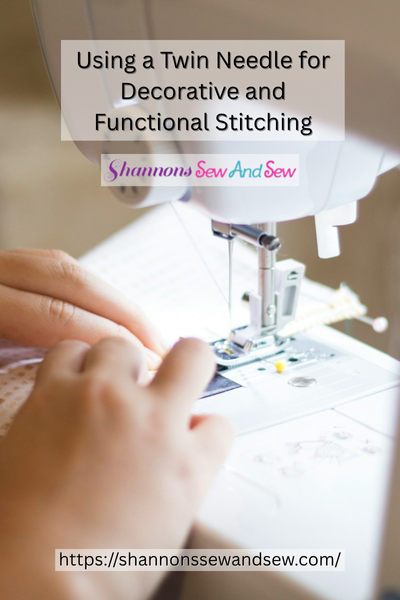Sewing Tips
Using a Twin Needle for Decorative and Functional Stitching
Using a twin needle for decorative and functional stitching changed the way I sew—and I honestly can’t believe I waited so long to try it. If you’ve ever looked at those crisp, professional-looking double rows of stitches on a T-shirt or thought, “How did they get that finish?”—yep, it’s probably a twin needle at work.
And guess what? It’s way less intimidating than it sounds.
Read More About Using a Twin Needle for Decorative and Functional Stitching

My First Time Using a Twin Needle (Spoiler: I Messed Up)
The first time I tried using a twin needle for decorative and functional stitching, I loaded it in backward. Yep, backward. I was so excited to test it out that I didn’t double-check anything. When the threads tangled up in a bird’s nest from sewing-machine hell, I stared at the mess like, “Okay, maybe I’m not cut out for this.”
But after a quick YouTube detour and a deep breath, I figured it out. And now? I’m kind of obsessed.
More Things to Know About Using a Twin Needle for Decorative and Functional Stitching

So, What Is a Twin Needle Anyway?
If you’ve never used one, a twin needle (or double needle) is basically two needles attached to one shank. It lets you sew two perfectly parallel lines at once—game-changer, right?
What’s cool is that using a twin needle for decorative and functional stitching doesn’t just look great—it strengthens your seams, reduces bulk, and can mimic coverstitching (without the fancy serger).
Decorative Stitching That Actually Feels Doable
You know those swoon-worthy details on store-bought clothes? With the twin needle, you can recreate them at home. Decorative stitches like waves, zigzags, and loops look incredibly polished when done with a twin needle. And you don’t need to go full Marie Kondo on your sewing stash either—just grab two spools of thread and a bobbin, and you’re golden.
One of my favorite tricks? Using variegated thread in one needle and a solid in the other. It adds this subtle, artsy touch without screaming “I tried too hard.”
It’s Not Just for the Pretty Stuff
Let’s not forget the functional side of using a twin needle for decorative and functional stitching. Hemming knit fabrics like jersey or interlock? This is where the twin needle really shines. It gives that professional double-stitch look on the outside and a stretchy zigzag on the inside (thanks to the shared bobbin thread).
Before I discovered this, my knit hems would stretch out and look… sad. Now they bounce back and look neat—no waving, no ripples, just clean results that hold up to washing and wearing.
Troubleshooting Tips (From Someone Who’s Been There)
Okay, full honesty: using a twin needle for decorative and functional stitching isn’t always smooth sailing. But here’s what I’ve learned from my trial-and-error-filled journey:
- Tension matters – Start with a test scrap, because every fabric behaves differently. Sometimes you’ll need to tweak the upper thread tension to avoid tunneling between stitches.
- Use a stretch twin needle for knits – This blew my mind. The regular twin needle was skipping stitches like crazy until I swapped it for a stretch version.
- Don’t forget the stabilizer – For lighter fabrics, a water-soluble stabilizer underneath can prevent puckering. I skipped this once and ended up with a bubbly hem that looked like it had opinions of its own.
Wait, Do You Need a Fancy Machine?
Not at all! If your sewing machine can do a straight stitch and has a zigzag foot, you’re probably good to go. Most standard machines have two spool pins or at least a way to improvise with a makeshift second one (I’ve balanced a second spool on a chopstick before—no shame).
And no, you don’t need to remortgage your house to buy special thread or accessories. Just regular thread in the same or contrasting colors will do just fine.
Level Up Your Sewing With a Twin Needle Finish
If you’ve been thinking about trying it but feeling intimidated, let me be the little voice that says: just go for it. Using a twin needle for decorative and functional stitching is one of those small upgrades that makes a huge difference in your projects.
You’ll be amazed at how much more polished your work looks—and how satisfying it feels to sew those clean double lines. It’s like giving your handmade pieces a little “heck yes, I made this!” energy.
So go ahead, dig through your machine accessories, grab that twin needle, and give it a whirl. And if you end up with a thread nest the first time? Hey, you’re not alone—I’ve been there too.




















